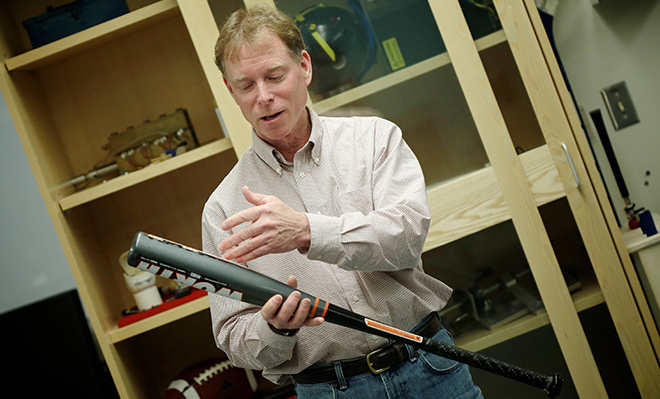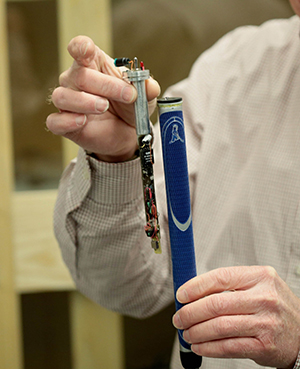BY JOHN GALLAGHER
DETROIT FREE PRESS
ORIGINAL STORY

A University of Michigan professor’s work in micro-sensor technology could change the way you understand your golf swing, free throw or fly-fishing technique.
One of the cooler items displayed at January’s Consumer Electronics Show in Las Vegas was the Wilson X Connected Football, a pigskin that includes an embedded sensor that can measure distance, speed, and spiral efficiency of a pass, and even whether the receiver catches or drops the ball.
Similar to the Wilson X Connected Basketball introduced the year before, the “smart” football derives its brainpower from work done by Noel Perkins, the Arthur F. Thurnau and Donald T. Greenwood Collegiate Professor of Mechanical Engineering. Perkins has been working on sensor technology for 15 years.
An avid fly-fisherman, Perkins first put miniature sensor technology onto his fly rod to measure the efficiency of his casts. Once he figured out how to download and analyze the data “it helped a ton,” he said.
Next came inserting the sensors into a golf club, followed by bowling balls, baseball bats, tennis rackets, footballs, basketballs, and more. Initially aimed at coaches and professional athletes, the sensor technology is quickly making its way into the consumer market, as the Wilson sporting goods demonstrate.
Perkins and his U-M colleague Stephen Cain currently are working on a contract with the U.S. Army to measure the performance of soldiers who have to carry heavy packs and other equipment. They attach sensors to a soldier’s boots, legs, back, torso and head to track how an individual moves. Databases that hold results from multiple individuals can then be analyzed to show how tiny changes in technique could improve efficiency.

“Coaches and trainers are relying on their naked eye to improve performance,” Perkins said. “Now you have technology that can measure motion to the nearest millisecond. No pun intended, but it’s an eye-opening change.”
Whether in footballs, basketballs, or fishing rods, the raw data is derived from the same sensors, called inertial sensors. Perkins and his colleagues have developed software using algorithms to interpret the thousands of pieces of data that athletes and their coaches can use to study performance, customized for each sport or activity.
“The data allow a rich understanding of performance that has never been achieved before,” Perkins said. “Even when using high speed film and video, athletes and coaches lack some of the data this technology provides, including important metrics of performance such as acceleration, spin axis and spin rate.”
In his lab on U-M’s north campus, Perkins displays the miniature circuit boards that contain the MEMS devices — micro electrical mechanical systems — that measure not only the acceleration of a moving object but also its rotation in several ways. A built-in wireless transmitter sends the data to a nearby laptop or mobile device, where software analyzes the data to explain performance.
Data on speed and rotation can be transmitted at the rate of 6,000 bits of data per second, fast enough to give an incredibly detailed look at a golf swing or how a quarterback throws a pass.
“It gives you the data to figure out in your technique what you are doing well, what you are doing poorly, and what is the bottleneck in terms of your performance,” Perkins said. “I think that’s the real value added, the very complete picture it gives.”
So far, Perkins and his colleagues have licensed their technology to six sporting goods companies since 2005, including giants like Wilson in 2014 and some smaller start-ups incubated at his lab. One of the start-ups, 94Fifty, markets its smart basketball with the pitch, “Meet your digital coach.” Another example is the start-up Diamond Kinetics whose product focuses on the swing of a baseball bat.
U-M’s Technology Transfer office, which works to translate university research into marketable products, helped with the licenses.
Smart sports equipment doesn’t come cheap, of course. Wilson’s smart basketball sells for about $200, compared with perhaps $20 or $30 for the old-fashioned type of ball at a local store. But for an athlete who’s serious about improving performance, the smart technology can deliver actionable intel.
The work of Perkins and Cain is a subset of the broader world of sensor technology. Similar devices developed by other researchers already are embedded in motor vehicles, wearable fitness trackers, the military’s smart bombs. Much more is coming. Without sensor technology the coming world of autonomous vehicles would be impossible.
“Where’s it going to end up? It’s going to be pervasive,” Perkins said. “Anything that moves and you want to know why it moves, how it moves, when it moves, is a candidate for this.”
